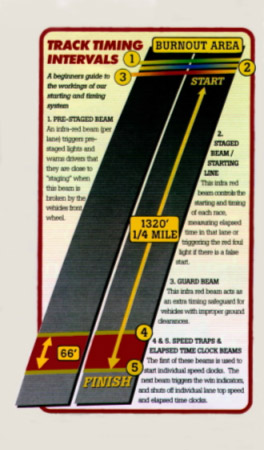What I have been seeing at my track is the MPH has been all over. Some days the mph at the 1/8th will higher in the right lane then the left or 1/4 will be higher in the other. I always try to run both lanes and analyze. The day I went 9.12 at 149 I was getting 151 in the other lane. I made 2 passes in right lane and went 119/151 mph but left lane was 120/149 mph. You sure would think if I went more mph in the 1/8th in one lane then it should have went more in the 1/4 but was the opposite. I always look at time and mph and try to come to the conclusion what make the most sense.
For the time the 170 is running and mph at the 1/8th there is a possibility the 1/4 mph is showing low. I would think this car should be picking up 30+ mph. Marc's time slip showing 122/155 mph for an 8.90 so 33 mph pick up. Very possibly the 170 actually ran 152-153 mph
This mph thing actually bothers me because it should always read the same. There have been times at my track where one lane is 4 mph higher then the other. When you can compare time slips for both lanes and they are the same increments all the way down but one is 4 mph higher you know one isn't right
All three time slips are the same lane so you can't compare the other lane to it. I need to look more into what could make the mph off. There are spots on the wall they line up the markers to so I don't know how they would be different unless the mph markers are different. Way back they used to tell you to "run it out the back door". That was because the mph markers were 66 feet before the 1/4 mile and 66 feet after the 1/4 where it was able to get an exact mph for the 1/4. They took out the after one so your mph is actually 33 feet before the finish line now because it is an average. I remember when they took them out and my mph on my 14 second car dropped 5 mph. Keep this in mind when looking at old time slips from the 70's. That car that went 13.9 at 105 would be closer 13.9 at 100 today
Found these to explain it
Previous to 1989, there were three timing lights at the end of the track; one AT the end of the quarter mile, and one 66 feet before, and one 66 feet after. The middle light was used to calculate the et of the run, and the time to travel the 132 feet at the end of the track was used to calculate the trap speed. This gave the average speed at the end of the track, but you can see what this lead to. Most of the racers stayed on the gas for an additional 66 feet past the quarter to get a consistent speed to evaluate their setup. The track's 'shut down area' of course is a fixed length, but the pro racers were starting to hit 300 mph plus by the end. In an attempt to get these guys off the gas 66 feet earlier and 'make' the cars appear slower, the NHRA stopped using the last light around August of 1989. Today, the trap speed is calculated between the light at the quarter mile and the one 66 feet before. So any timeslip after 1989 is really giving the average speed 33 feet from the finish, which is pretty close to one percent slower than before. The old constant of 230.5 became 228.4 to compensate.
MILES PER HOUR TIMER
Also known as the speed trap, this timer is located 66 feet before the finish line. It records the car’s average speed between it and the finish line. This is the mile per hour figure on your time slip.

1
1

